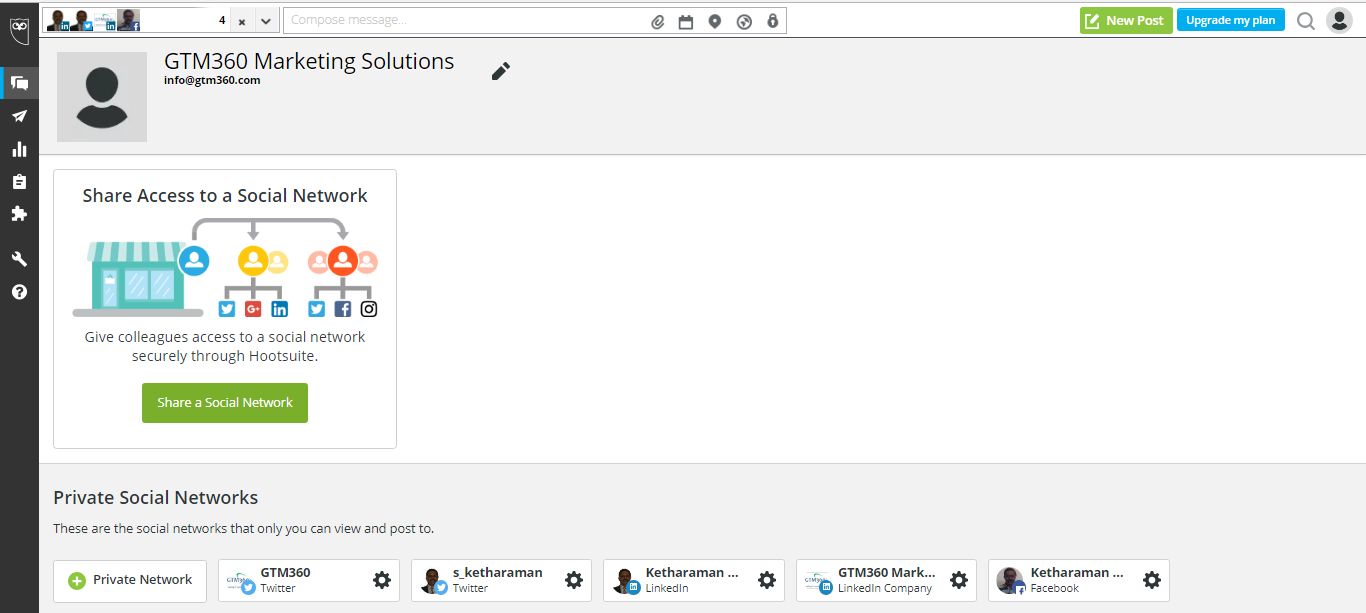SAAS users experience frequent UI changes. The sales order button suddenly moves from top left to bottom right of the screen. The funnel report disappears from the splash screen.
I could go on and on but the point is, frequent changes in UI drain productivity and escalate training costs. Beyond a certain extent, they might even drive customers to cancel their subscription aka cause churn.
Both of these are bad news for SAAS vendors. See my earlier post Thriving On Chaos Of SMAC Architecture for the full impact of UI changes on SAAS renewals.
But vendors have their own reason for tweaking screens and menus.
So, it seems like SAAS providers and SAAS users have hit a stalemate.
Enter AI in UI – a low hanging fruit for breaking the impasse.
Hootsuite helps social media marketing professionals view feeds from multiple social networks on a single dashboard. Likewise, it lets content marketers cross-post their updates across Twitter, LinkedIn, Facebook, and other popular social networks from a single publisher screen. Instead of logging into each social network individually to publish their posts repeatedly, users need to type their post only once on Hootsuite’s Compose message box and Hootsuite posts it on multiple social networks simultaneously.
To support cross-viewing and cross-posting, Hootsuite asks users to share access to their individual social network accounts on the following screen:

Hootsuite automatically routes new users through this screen during their onboarding process.
Users can visit this screen manually when they wish add a new social network profile to Hootsuite.
![]() Users also need to visit this screen when Hootsuite informs them that a certain scheduled message failed to post most probably because it faced a “problem communicating with the social network account”. I don’t know what causes this problem but I face it often, especially with LinkedIn Company profiles.
Users also need to visit this screen when Hootsuite informs them that a certain scheduled message failed to post most probably because it faced a “problem communicating with the social network account”. I don’t know what causes this problem but I face it often, especially with LinkedIn Company profiles.
The solution is simple: Simply reconnect to the broken social network account by first clicking the owl icon appearing on the top left of the screen and then the Manage social networks link located at the bottom of the panel on the left hand side.
In the past, this used to take merely 30 seconds.
But, after a recent UI change, the owl icon was not clickable and the menu item Manage social networks was not visible anywhere on the left panel. I didn’t know how to reconnect the said LinkedIn Company account to Hootsuite.
I reached out to Hootsuite on Twitter, my preferred channel for reaching out to companies and brands (see Why Social Media Has Become My First Port Of Call For Customer Service).
@Hootsuite_Help Suddenly, the owl logo on upper LHS of dashboard is unclickable. I'm unable to re-authenticate my LinkedIn Company a/c.
— Ketharaman Swaminathan (@s_ketharaman) September 22, 2017
I got an email back from Hootsuite saying I could find the Manage social networks link in Profile section on the top right hand side of the screen. I could.
Problem solved.
![]() While this issue was resolved quickly, I was wondering if it could be prevented from occurring in the first place.
While this issue was resolved quickly, I was wondering if it could be prevented from occurring in the first place.
My train of thought went thus:
- Hootsuite has sent me a notification that my message failed to post on a certain social network account
- This means I need to reconnect the broken account
- My clickstream would reveal that I tried to click the owl icon repeatedly
- In the past, after clicking the owl icon, I’ve clicked the Manage social networks link to reconnect the broken profile
- That’s what I must be trying to do this time.
Hootsuite has all this information. Instead of waiting for me to face a problem and contact its CSR, I felt the software could use (a) Artificial Intelligence to process the aforementioned data and issue a trigger that prompts me to look for the Manage social networks link in its new location, and (b) Machine Learning to seek my feedback on whether its prompt was useful or not, thus improving the quality of its future triggers.
If Hootsuite did that, I’d have a superior user experience and wouldn’t seek support from the company.
 I could find examples of AI in UI from other enterprise application providers.
I could find examples of AI in UI from other enterprise application providers.
Oracle recently announced Ambient Human Interfaces, a new AI-powered User interface for its ERP software. In this article, Thomas Kurian, Oracle president of product development, uses the following example to explain how AI-powered UI can take productivity to the next level:
With such an interface on a procurement application, when you as a manager are alerted to a purchase order you must review, you could still access it the traditional way, via a web browser or mobile app. Or, you could get help through a “virtual assistant”— asking for the PO, asking questions about its contents, and then giving your okay.
In Bots Are Critical For ERP Adoption In The Market, Virender Aggarwal, CEO of Ramco Systems, observes, “Bots fall under the overall umbrella of user experience which is critical for ERP adoption in the market” and goes on to illustrate the role of AI-powered UI envisaged by the maker of cloud and mobile enterprise software:
To give a quick example of how bots can improve productivity, here’s a use case from aviation. In a non-bot environment, a mechanic at the hangar working on an aircraft, would have required to travel to his work station to login and raise a request for a part. With mobility and a chatbot in place, the part buyer just enters his email address and password and then begins a perfectly natural conversation about securing a replacement part from different potential sources. The buyer can approve, reject, ask for a better price or delay a decision, all in natural language. Special-purpose Ramco bots, like an AOG bot, developed for the aviation industry, would help a mechanic easily get necessary information from maintenance documents and vendors.
While it’s still early days, I’m gung-ho about the potential of AI in UI to increase productivity, improve UX and reduce churn of SAAS software.
(Full Disclosure: I’m an ex-employee of Oracle and Ramco Systems.)
